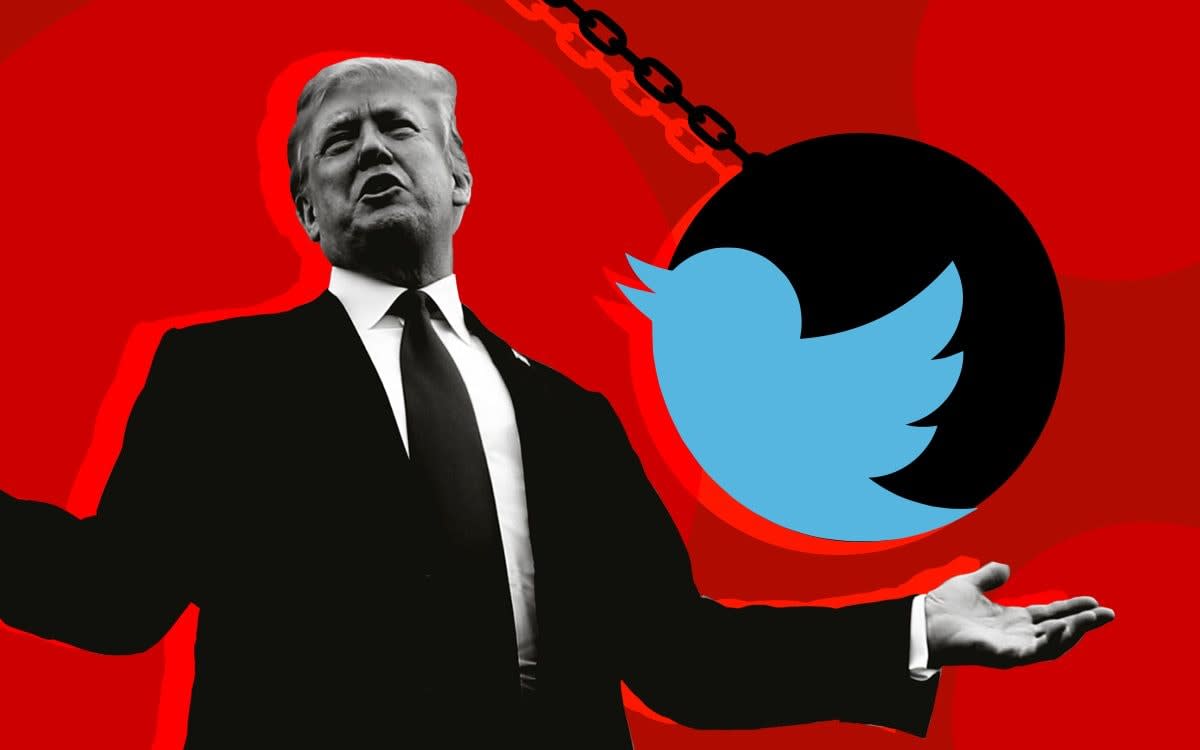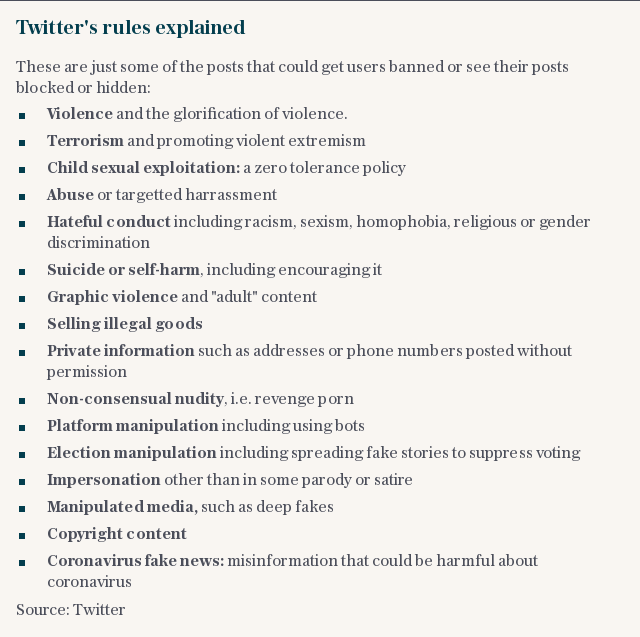Why Twitter can't ban Donald Trump – despite him breaking the rules

President Donald Trump’s latest Twitter attacks have many people wondering: why doesn’t Twitter simply ban him from the social network?
The US President has repeatedly been on the wrong side of many of the site’s long list of rules, according to his critics.
The latest saga has seen two of Trump’s Tweet’s flagged, one for claiming an election could be rigged and another for apparently glorifying violence. Trump, however, wants to change the law to crack down on social media companies.
But if the President keeps breaking the rules, why doesn’t Twitter just ban him completely?
As well as causing a political firestorm, it would actually be quite hard to do this under Twitter’s rules. Here's why.
Twitter is doing nothing about all of the lies & propaganda being put out by China or the Radical Left Democrat Party. They have targeted Republicans, Conservatives & the President of the United States. Section 230 should be revoked by Congress. Until then, it will be regulated!
— Donald J. Trump (@realDonaldTrump) May 29, 2020
World leader defence
Twitter has openly admitted that it has a different set of standards for world leaders such as Trump.
The issue of banning Trump has come up before. Last year, Trump repeatedly attacked a whistleblower who was bringing evidence against him before the US senate, leading one Democrat senator to call for him to be banned.
Alex Krasodomski-Jones, a director at think tank Demos, says opponents had been calling for a ban before, “largely to make political points rather than any real expectation that he's going to get banned like any other user.”
After years of Trump using Twitter in a controversial way, the site responded. Twitter said: “When it comes to the actions of world leaders on Twitter… We understand the desire for our decisions to be ‘yes/no’ binaries, but it’s not that simple.”
There continues to be meaningful public conversation about how we think about Tweets from world leaders on our service. We welcome the conversation and want to share more context on our principles and process for reviewing Tweets from these accounts. https://t.co/UlbdUVIeV9
— Twitter Safety (@TwitterSafety) October 15, 2019
It said that, while normal accounts may be banned or have posts removed for repeated violations, with world leaders, it would in many cases leave these up online if “there is a clear public interest value”.
World leaders would instead see their posts placed behind a warning. Twitter said removing world leaders' posts would create a dangerous precedent for censorship.
It did, however, say that some comments such as inciting terrorism, posting private information about individuals so they can be harrassed, posting intimate photos without permission, child pornography or promoting self-harm could all see a post immediately banned, regardless of whether it was from a world leader.
The public interest
In another edit to its rules last year, Twitter argued that posts from senior politicians and world leaders could be defined as in the public interest, even if they broke rules around hate speech or violence.
It set out specific rules that surround elected officials to make what they say noteworthy and defensible. Users must be an elected official or running for public office, have more than 100,000 followers, and be “verified” with a blue check mark. Trump’s 80 million followers mean he falls under this defence.
Twitter said: “There are certain cases where it may be in the public’s interest to have access to certain Tweets, even if they would otherwise be in violation of our rules.”
This may seem unfair to many, but Demos’s Krasodomski-Jones says this approach was inevitable.
“Donald Trump is not anybody, he's a privileged user in the same way that any advertiser that spends a fortune on a social media platform might well expect to receive preferential treatment,” he says.

Twitter’s special Trump protections
Insiders say the social network introduced a series of added internal controls in 2017 after a contractor managed to suspend Trump’s Twitter account on his last day working for Twitter. The contractor who suspended Trump, later said it was a “mistake” and he did not believe Trump’s account would have been deactivated.
Twitter has since taken steps to limit how many people inside the company are able to make changes to Trump’s account, meaning only the most senior employees would be able to suspend or ban him.
Jack Dorsey, Twitter’s chief executive, even hinted he would have final say on any such decisions. He said this week: “Fact check: There is someone ultimately accountable for all our actions as a company, and that’s me.”
A spokesman said this week that Dorsey was alerted to the company’s decision to hide Trump’s tweet threatening violence before the post was hidden.
Removing Trump would be damaging to Twitter
Twitter has other reasons for being cautious about removing Trump. First, the political fallout of removing a President would be hugely damaging from Republicans who want to regulate social media.
It could also be legally difficult. A previous court case ruled Trump’s Twitter account was effectively “an official, state-run account” as judges barred him from “blocking” users he disliked, as it shut down their free speech. Barring Trump’s own account could cause its own legal issues.
Finally, Trump is very valuable to Twitter, according to analysts. In 2017, analyst James Cakmak estimated Trump’s account was worth at least $2bn to Twitter, largely based on the intangible value and prominence it gave to the site.
If Twitter, won’t ban Trump, what will it do?
So far, Twitter has taken action against two of Trump’s posts. The first post was a Tweet complaining that postal ballots in California could lead to fraud, specifically with Trump alleging this could lead to a “Rigged Election”. In response, Twitter posted a link saying users should “get the facts”, directing them to a news story debunking Trump’s claim.
The second, more serious, post was on Friday morning. Trump posted about the protests surrounding George Floyd, a black man killed in Minneapolis while in police custody. As the protests escalated into rioting, Trump said: “Any difficulty and we will assume control but, when the looting starts, the shooting starts.”
We have placed a public interest notice on this Tweet from @realdonaldtrump. https://t.co/6RHX56G2zt
— Twitter Comms (@TwitterComms) May 29, 2020
This was taken by Twitter to be glorification of violence. His Tweet was hidden behind a content warning, but not deleted. Twitter also prevented it from being re-Tweeted and shared further.
Ultimately, Twitter is a private company. In the US, it has first amendment protections that mean it could, probably, ban Trump. But that doesn’t mean it ever would, at least not while he is President.
Trump’s plan could backfire
The president has urged Congress to revoke Section 230, a law protecting free speech on the internet, in an attempt to make the company liable for what he called “lies & propaganda” in a tweet published on Friday.
But Trump’s plan may end up backfiring. Kate Ruane, a lawyer at the American Civil Liberties Union, told the New York Times that if sites like Twitter lose their legal protection from content on their platform, one of the first users to be booted off may be Donald Trump.

